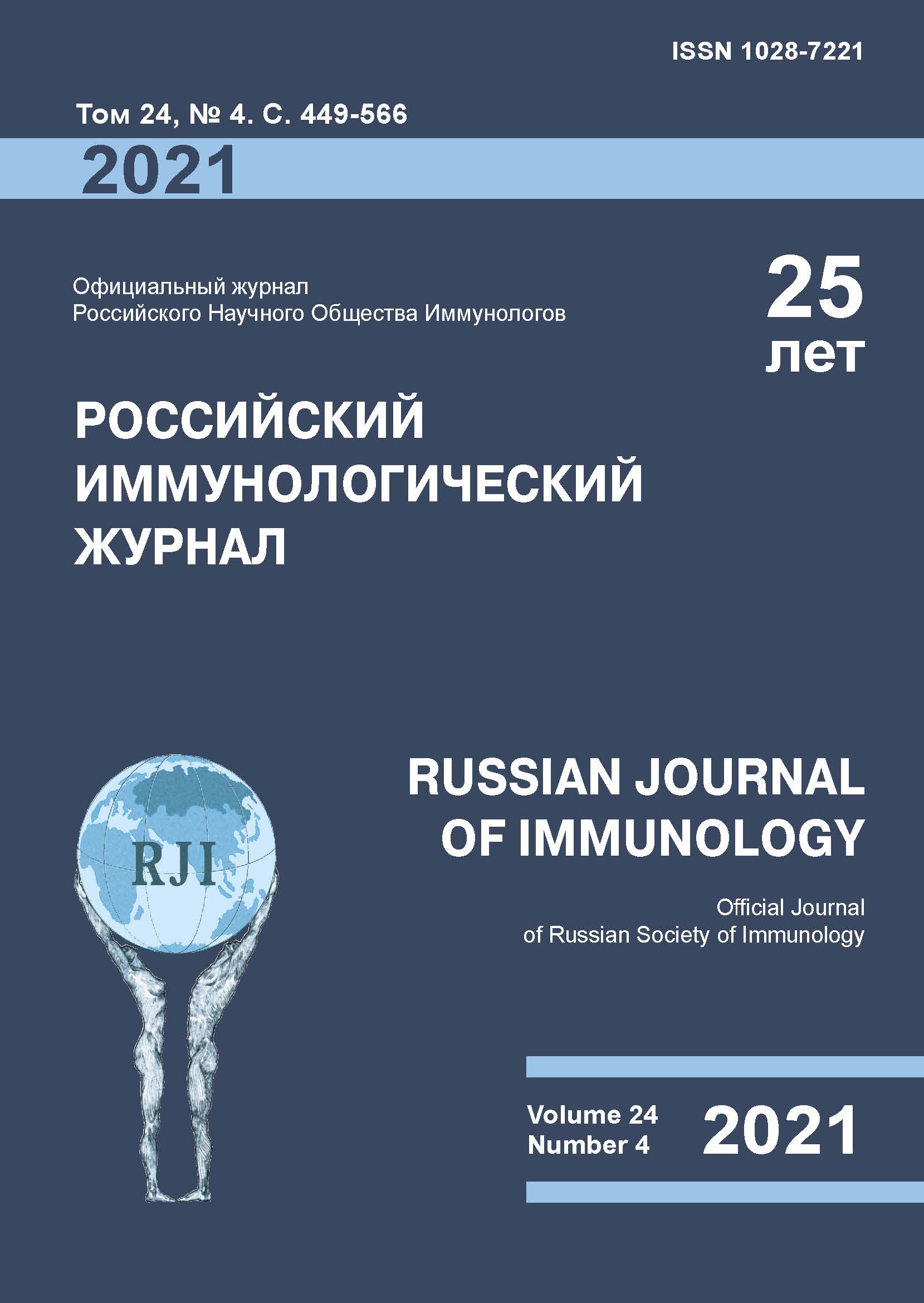Дисфункция врожденного иммунитета у пациентов с послеоперационными когнитивными нарушениями после аортокоронарного шунтирования
- Авторы: Маркелова Е.В.1, Зенина А.А.1,2, Силаев А.А.2, Чагина Е.А.1, Федянина Л.Н.2
-
Учреждения:
- ФГБОУ ВО «Тихоокеанский государственный медицинский университет» Министерства здравоохранения РФ
- ФГАОУ ВО «Дальневосточный федеральный университет»
- Выпуск: Том 24, № 4 (2021)
- Страницы: 507-512
- Раздел: КРАТКИЕ СООБЩЕНИЯ
- Дата подачи: 08.07.2021
- Дата принятия к публикации: 20.08.2021
- Дата публикации: 15.10.2021
- URL: https://rusimmun.ru/jour/article/view/1043
- DOI: https://doi.org/10.46235/1028-7221-1043-CID
- ID: 1043
Цитировать
Полный текст
Аннотация
Учитывая значимость послеоперационных когнитивных нарушений, в настоящее время активно ведется поиск биологических маркеров этих неврологических осложнений. Проведен сравнительный анализ NSE, IL-6, TGF-β1, MMP9 и TIMP1 в сыворотке крови исследуемых пациентов.
В исследовании участвовали 110 человек после аортокоронарного шунтирования с использованием искусственного кровообращения. Разделение на группы выполнено на основании разницы данных тестирования по Монреальской шкале нейропсихологического обследования до операции и на 7-е сутки после операции. В I группу отнесены пациенты без осложнений с изменениями менее 3 баллов, во II – пациенты с послеоперационными когнитивными осложнениями и отклонением при тестировании более 3 баллов. Также для сравнения использовалась III группа – 35 относительно здоровых человек. Исследование уровня NSE, IL-6, TGF-β1, ММP9 и TIMP1 в сыворотке крови проводилось методом твердофазного иммуноферментного анализа (R&D Systems, США). Результаты выражали в пг/мл и нг/мл. Проводилось черыре этапа исследования: до операции, сразу после операции, через 24 часа и на 7-е сутки после операции.
Обнаружен более высокий уровень NSE у пациентов II группы, за исключением на 7-е сутки после операции, где его концентрация выравнивается между группами. Было выявлено более повышенное содержание IL-6 у пациентов II группы во все периоды после операции. Отмечена более низкая концентрация TGF-β1 во II группе в периоды до операции, через 24 часа и на 7-е сутки после операции. Тогда как в период после операции зарегистрировано его повышение и значение мало отличается от I и III группы. По данным исследования MMP9, значимые различия между I и II группами были выявлены только на 7-е сутки после операции. Однако обращает внимание более низкое содержание этого показателя у пациентов I и II групп до операции по сравнению с III группой. Значения ТIМP1 в течении всех периодов исследования плавно повышалось, но существенно не отличались между I и II группами.
У пациентов II группы установлено увеличение NSE и IL-6, низкий уровень TGF-β1 и снижение соотношения ММP9/TIMP1 в раннем послеоперационном периоде, что свидетельствует о вовлеченности дисфункции врожденного иммунитета в патогенез ПОКД.
Ключевые слова
Об авторах
Е. В. Маркелова
ФГБОУ ВО «Тихоокеанский государственный медицинский университет» Министерства здравоохранения РФ
Email: fake@neicon.ru
д.м.н., профессор, заведующая кафедрой нормальной и патологической физиологии
690105, Россия, г. Владивосток, ул. Невельского, 1, кв.208
РоссияА. А. Зенина
ФГБОУ ВО «Тихоокеанский государственный медицинский университет» Министерства здравоохранения РФ;ФГАОУ ВО «Дальневосточный федеральный университет»
Автор, ответственный за переписку.
Email: Zenina.aa@dvfu.ru
аспирант кафедры нормальной и патологической физиологии; врач анестезиолог-реаниматолог
690105, Россия, г. Владивосток, ул. Невельского, 1, кв.208
Тел.: 8 (914) 707-26-52
РоссияА. А. Силаев
ФГАОУ ВО «Дальневосточный федеральный университет»
Email: fake@neicon.ru
к.м.н., заведующий отделением анестезиологии, реанимации и интенсивной терапии
Владивосток
РоссияЕ. А. Чагина
ФГБОУ ВО «Тихоокеанский государственный медицинский университет» Министерства здравоохранения РФ
Email: fake@neicon.ru
к.м.н., доцент кафедры нормальной и патологической физиологии
690105, Россия, г. Владивосток, ул. Невельского, 1, кв.208
РоссияЛ. Н. Федянина
ФГАОУ ВО «Дальневосточный федеральный университет»
Email: fake@neicon.ru
д.м.н., профессор, профессор департамента фундаментальной медицины Школы биомедицины
Владивосток
РоссияСписок литературы
- Левин C.Г., Годухин О.В. Модулирующее действие цитокинов на механизмы синаптической пластичности в мозге // Биохимия, 2017. Т. 82, № 3. С. 397-409.
- Bogoslovsky T., Gill J., Jeromin A., Davis C., Diaz-Arrastia R. Fluid biomarkers of traumatic brain injury and intended context of use. Diagnostics (Basel), 2016, Vol. 6, no. 4, 37. doi: 10.3390/diagnostics6040037.
- Casault C., Al Sultan A.S., Banoei M., Couillard P., Kramer A., Winston B.W. Cytokine responses in severe traumatic brain injury: where there is smoke, is there fire? Neurocrit. Care, 2019, Vol. 30, no. 1, pp. 22-32.
- Evered L., Silbert B., Knopman D.S., Scott D.A., DeKosky S.T., Rasmussen L.S., Oh E.S., Crosby G., Berger M., Eckenhoff R.G. The Nomenclature Consensus Working Group Recommendations for the nomenclature of cognitive change associated with anaesthesia and surgery. Br. J.Anaesth., 2018, Vol. 121, no. 5, pp. 1005-1012.
- Jassam Y.N., Izzy S., Whalen M., McGavern D.B., El Khoury J. Neuroimmunology of traumatic brain injury: time for a paradigm shift. Neuron, 2017. Vol. 95, no. 6, pp. 1246-1265.
- Lin X., Chen Y., Zhang P., Chen G., Zhou Y., Yu X. The potential mechanism of postoperative cognitive dysfunction in older people. Exp. Gerontol., 2020, Vol. 130, 110791. doi: 10.1016/j.exger.2019.110791.
- Rempe R.G., Hartz A.M., Bauer B. Matrix metalloproteinases in the brain and blood–brain barrier: versatile breakers and makers. J. Cereb. Blood Flow Metabol., 2016, Vol. 36, no. 9, pp. 1481-1507.
- Rothaug M., Becker-Pauly C., Rose-John S. The role of interleukin-6 signaling in nervous tissue. Biochim. Biophys. Acta, 2016, Vol. 1863, no. 6, Pt A, pp. 1218-1227.
- Silva F.P., Schmidt A.P., Valentin L.S., Pinto K.O., Zeferino S.P., Oses J.P. S100B protein and neuron-specific enolase as predictors of cognitive dysfunction after coronary artery bypass graft surgery. Eur. J. Anaesthesiol., 2016, Vol. 33, pp
Дополнительные файлы







